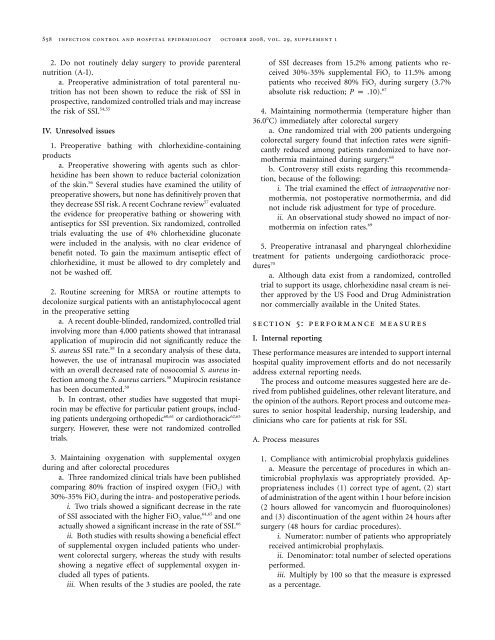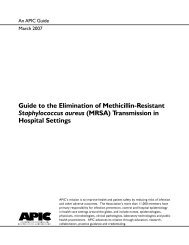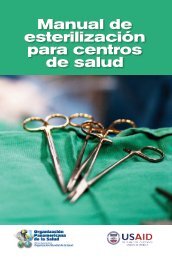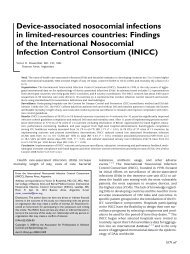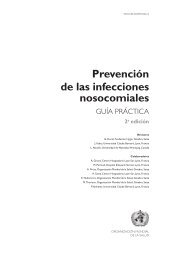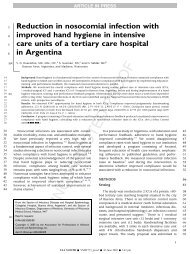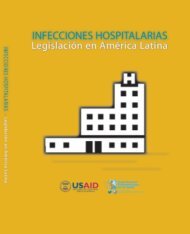Strategies to Prevent Surgical Site Infections in Acute Care Hospitals
Strategies to Prevent Surgical Site Infections in Acute Care Hospitals
Strategies to Prevent Surgical Site Infections in Acute Care Hospitals
You also want an ePaper? Increase the reach of your titles
YUMPU automatically turns print PDFs into web optimized ePapers that Google loves.
S58 <strong>in</strong>fection control and hospital epidemiology oc<strong>to</strong>ber 2008, vol. 29, supplement 12. Do not rout<strong>in</strong>ely delay surgery <strong>to</strong> provide parenteralnutrition (A-I).a. Preoperative adm<strong>in</strong>istration of <strong>to</strong>tal parenteral nutritionhas not been shown <strong>to</strong> reduce the risk of SSI <strong>in</strong>prospective, randomized controlled trials and may <strong>in</strong>creasethe risk of SSI. 54,55IV. Unresolved issues1. Preoperative bath<strong>in</strong>g with chlorhexid<strong>in</strong>e-conta<strong>in</strong><strong>in</strong>gproductsa. Preoperative shower<strong>in</strong>g with agents such as chlorhexid<strong>in</strong>ehas been shown <strong>to</strong> reduce bacterial colonizationof the sk<strong>in</strong>. 56 Several studies have exam<strong>in</strong>ed the utility ofpreoperative showers, but none has def<strong>in</strong>itively proven thatthey decrease SSI risk. A recent Cochrane review 57 evaluatedthe evidence for preoperative bath<strong>in</strong>g or shower<strong>in</strong>g withantiseptics for SSI prevention. Six randomized, controlledtrials evaluat<strong>in</strong>g the use of 4% chlorhexid<strong>in</strong>e gluconatewere <strong>in</strong>cluded <strong>in</strong> the analysis, with no clear evidence ofbenefit noted. To ga<strong>in</strong> the maximum antiseptic effect ofchlorhexid<strong>in</strong>e, it must be allowed <strong>to</strong> dry completely andnot be washed off.2. Rout<strong>in</strong>e screen<strong>in</strong>g for MRSA or rout<strong>in</strong>e attempts <strong>to</strong>decolonize surgical patients with an antistaphylococcal agent<strong>in</strong> the preoperative sett<strong>in</strong>ga. A recent double-bl<strong>in</strong>ded, randomized, controlled trial<strong>in</strong>volv<strong>in</strong>g more than 4,000 patients showed that <strong>in</strong>tranasalapplication of mupiroc<strong>in</strong> did not significantly reduce theS. aureus SSI rate. 58 In a secondary analysis of these data,however, the use of <strong>in</strong>tranasal mupiroc<strong>in</strong> was associatedwith an overall decreased rate of nosocomial S. aureus <strong>in</strong>fectionamong the S. aureus carriers. 58 Mupiroc<strong>in</strong> resistancehas been documented. 59b. In contrast, other studies have suggested that mupiroc<strong>in</strong>may be effective for particular patient groups, <strong>in</strong>clud<strong>in</strong>gpatients undergo<strong>in</strong>g orthopedic 60,61 or cardiothoracic 62,63surgery. However, these were not randomized controlledtrials.3. Ma<strong>in</strong>ta<strong>in</strong><strong>in</strong>g oxygenation with supplemental oxygendur<strong>in</strong>g and after colorectal proceduresa. Three randomized cl<strong>in</strong>ical trials have been publishedcompar<strong>in</strong>g 80% fraction of <strong>in</strong>spired oxygen (FiO 2 ) with30%-35% FiO 2 dur<strong>in</strong>g the <strong>in</strong>tra- and pos<strong>to</strong>perative periods.i. Two trials showed a significant decrease <strong>in</strong> the rateof SSI associated with the higher FiO 2 value, 64,65 and oneactually showed a significant <strong>in</strong>crease <strong>in</strong> the rate of SSI. 66ii. Both studies with results show<strong>in</strong>g a beneficial effec<strong>to</strong>f supplemental oxygen <strong>in</strong>cluded patients who underwentcolorectal surgery, whereas the study with resultsshow<strong>in</strong>g a negative effect of supplemental oxygen <strong>in</strong>cludedall types of patients.iii. When results of the 3 studies are pooled, the rateof SSI decreases from 15.2% among patients who received30%-35% supplemental FiO 2 <strong>to</strong> 11.5% amongpatients who received 80% FiO 2 dur<strong>in</strong>g surgery (3.7%absolute risk reduction; P p .10). 674. Ma<strong>in</strong>ta<strong>in</strong><strong>in</strong>g normothermia (temperature higher than36.0C) immediately after colorectal surgerya. One randomized trial with 200 patients undergo<strong>in</strong>gcolorectal surgery found that <strong>in</strong>fection rates were significantlyreduced among patients randomized <strong>to</strong> have normothermiama<strong>in</strong>ta<strong>in</strong>ed dur<strong>in</strong>g surgery. 68b. Controversy still exists regard<strong>in</strong>g this recommendation,because of the follow<strong>in</strong>g:i. The trial exam<strong>in</strong>ed the effect of <strong>in</strong>traoperative normothermia,not pos<strong>to</strong>perative normothermia, and didnot <strong>in</strong>clude risk adjustment for type of procedure.ii. An observational study showed no impact of normothermiaon <strong>in</strong>fection rates. 695. Preoperative <strong>in</strong>tranasal and pharyngeal chlorhexid<strong>in</strong>etreatment for patients undergo<strong>in</strong>g cardiothoracic procedures70a. Although data exist from a randomized, controlledtrial <strong>to</strong> support its usage, chlorhexid<strong>in</strong>e nasal cream is neitherapproved by the US Food and Drug Adm<strong>in</strong>istrationnor commercially available <strong>in</strong> the United States.section 5: performance measuresI. Internal report<strong>in</strong>gThese performance measures are <strong>in</strong>tended <strong>to</strong> support <strong>in</strong>ternalhospital quality improvement efforts and do not necessarilyaddress external report<strong>in</strong>g needs.The process and outcome measures suggested here are derivedfrom published guidel<strong>in</strong>es, other relevant literature, andthe op<strong>in</strong>ion of the authors. Report process and outcome measures<strong>to</strong> senior hospital leadership, nurs<strong>in</strong>g leadership, andcl<strong>in</strong>icians who care for patients at risk for SSI.A. Process measures1. Compliance with antimicrobial prophylaxis guidel<strong>in</strong>esa. Measure the percentage of procedures <strong>in</strong> which antimicrobialprophylaxis was appropriately provided. Appropriateness<strong>in</strong>cludes (1) correct type of agent, (2) star<strong>to</strong>f adm<strong>in</strong>istration of the agent with<strong>in</strong> 1 hour before <strong>in</strong>cision(2 hours allowed for vancomyc<strong>in</strong> and fluoroqu<strong>in</strong>olones)and (3) discont<strong>in</strong>uation of the agent with<strong>in</strong> 24 hours aftersurgery (48 hours for cardiac procedures).i. Numera<strong>to</strong>r: number of patients who appropriatelyreceived antimicrobial prophylaxis.ii. Denom<strong>in</strong>a<strong>to</strong>r: <strong>to</strong>tal number of selected operationsperformed.iii. Multiply by 100 so that the measure is expressedas a percentage.


